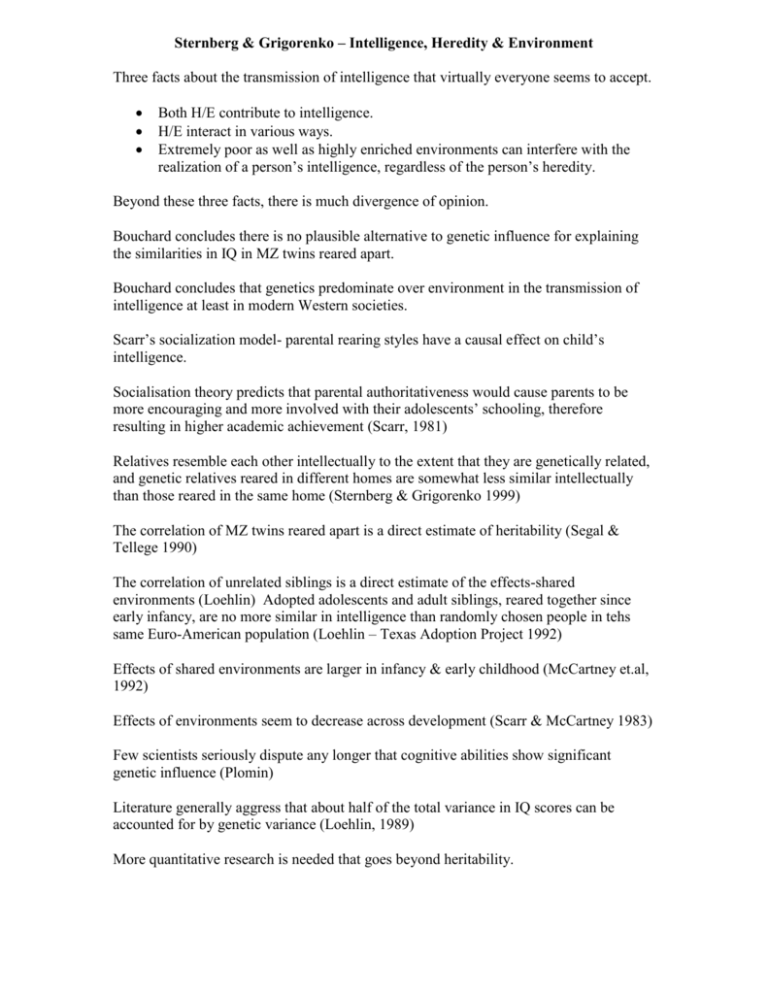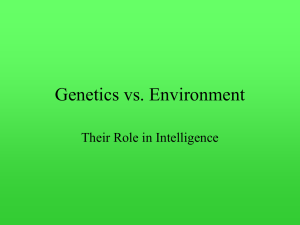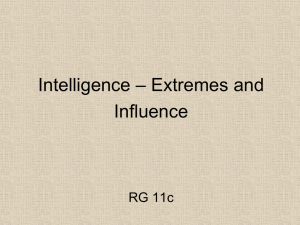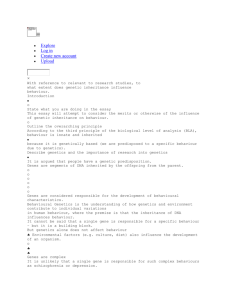Sternberg & Grigorenko – Intelligence, Heredity & Environment
advertisement

Sternberg & Grigorenko – Intelligence, Heredity & Environment Three facts about the transmission of intelligence that virtually everyone seems to accept. Both H/E contribute to intelligence. H/E interact in various ways. Extremely poor as well as highly enriched environments can interfere with the realization of a person’s intelligence, regardless of the person’s heredity. Beyond these three facts, there is much divergence of opinion. Bouchard concludes there is no plausible alternative to genetic influence for explaining the similarities in IQ in MZ twins reared apart. Bouchard concludes that genetics predominate over environment in the transmission of intelligence at least in modern Western societies. Scarr’s socialization model- parental rearing styles have a causal effect on child’s intelligence. Socialisation theory predicts that parental authoritativeness would cause parents to be more encouraging and more involved with their adolescents’ schooling, therefore resulting in higher academic achievement (Scarr, 1981) Relatives resemble each other intellectually to the extent that they are genetically related, and genetic relatives reared in different homes are somewhat less similar intellectually than those reared in the same home (Sternberg & Grigorenko 1999) The correlation of MZ twins reared apart is a direct estimate of heritability (Segal & Tellege 1990) The correlation of unrelated siblings is a direct estimate of the effects-shared environments (Loehlin) Adopted adolescents and adult siblings, reared together since early infancy, are no more similar in intelligence than randomly chosen people in tehs same Euro-American population (Loehlin – Texas Adoption Project 1992) Effects of shared environments are larger in infancy & early childhood (McCartney et.al, 1992) Effects of environments seem to decrease across development (Scarr & McCartney 1983) Few scientists seriously dispute any longer that cognitive abilities show significant genetic influence (Plomin) Literature generally aggress that about half of the total variance in IQ scores can be accounted for by genetic variance (Loehlin, 1989) More quantitative research is needed that goes beyond heritability. Texas Adoption Project – shared family environments have an appreciable effect on IQ when children are small, but this becomes minor by the time they are late adolescents (Loehlin et.al, 1992) Birth mothers showed, if anything, higher IQ correlations with the children they had had not contact with since near birth than the adoptive parents did with their own biological children with whom they had lived all their lives. The genetic effects on IQ increase with age (Texas Adoption Project) Galton (1876) can be credited with introducing the twin method but never mentioned twins reared apart. Reaction range introduced by Gottesman (1968) Reaction Range attempts to illustrate the degree to which genotypes have variable expression in different environments. Bouchard (in Sternberg & Grigorenko) concludes that genetic factors are the predominant source of variation in adult measured intelligence in Western societies. Epigenesis – H/E are active self-organizing systems that co-participate with other selforganizing systems to determine intellectual development jointly (Biddell & Fischer) Epigenesis – genetics and environment are viewed not as separate, independent forces influencing intelligence but as intrinsically related integrative systems that take part in and are parts of the developing person. The epigenesis of intelligence is a constructive process i.e. Humans determine our own cognitive outcomes as we actively make sense out of our world and build skills for participation in it. (Biddell & Fischer) Need to discuss the relative contributions of H/E and not either/or (Gordon & Lemons) Eysenck (1971) and Jensen (1969) have emerged as the principal spokespersons for heredity as the primary determinant of the quality of intelligence. Hernstein (1994) supports this position. Overview of recent behaviour-genetic studies of intelligence Loehlin (1989) – familial correlations from a wide variety of relationships e.g. identical twins reared apart Genetic influence on general cognitive ability appear to be substantial with heritability estimates (h2) ranging from .4 to .8 i.e. 40-80% of the variability in general cognitive ability among individuals is due to genetic differences among them Social status, financial earnings and educational success are all closely linked with high IQ, similarly social failure, unemployment and poverty are often associated with low IQ (Cattell 1983)










